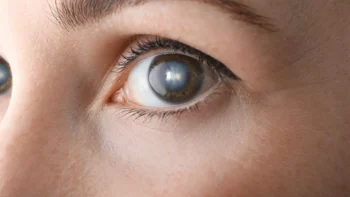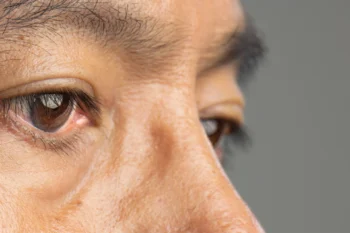What Is The Connection Between Your Thyroid and Eye Problems?
The thyroid gland is commonly linked with mood imbalances, weight changes, and tiredness. But, what often goes unnoticed is that undetected thyroid conditions may result in significant and persistent vision-related problems, primarily caused by autoimmune disorders that arise from an unhealthy thyroid gland. Below, we’ve compiled a list of these disorders, alongside what they are and what symptoms appear with them.
7 Thyroid Eye Problems
1. Thyroid Eye Disease (TED), also called Graves’ ophthalmopathy, or thyroid-associated ophthalmopathy (TAO), is an autoimmune disorder that causes swelling in the areas surrounding your eye, damaging them in the process. It is frequently related to a similar condition, Graves’ disease, which is another autoimmune disorder wherein the immune system attacks the thyroid gland, causing hyperthyroidism (see more below on this). Despite being two separate conditions, they have a tendency to occur in the same patients approximately 90% of the time, resulting in symptoms such as; dry eyes, light sensitivity, watery eyes, blurry vision, double vision, reddened sclera (whites of the eyes), as well as red, swollen, pulled back eyelids and, most commonly, the appearance of bulging eyes (proptosis).
2. Hyperparathyroidism refers to a specific part of the thyroid, the parathyroid gland, being overactive, which is called Primary Hyperparathyroidism (PTH). The parathyroid emits slightly different hormones, also called PTH, that are responsible for regulating calcium levels in the body. PTH causes calcium levels to rise, leading to symptoms like weak bones, kidney stones, abdominal pain and fatigue. According to a study in 2012, hyperparathyroidism eye problems, while rare, have been documented and can present as calcium deposits in the eyes, or as red eye as a result of scleritis.
3. Hashimoto’s thyroiditis is a slow-progression, autoimmune disorder where the individual’s immune system attacks the healthy tissues of the thyroid gland, leading to a decline in hormone production (hypothyroidism – an underactive thyroid – which we cover more below). While it can cause symptoms like fatigue, daytime sleepiness, dry skin/nails, muscles weakness and aches, depression, hair loss, and more, it can also lead to eye problems. The eye problems are directly related to the hypothyroidism, which may manifest as puffiness around the eyes, dryness, and redness. Additionally, the autoimmune response caused by Hashimoto’s thyroiditis can lead to thyroid eye disease (TED), which may manifest as bulging eyes, double vision, light sensitivity, and eye pain.
4. Hyperthyroidism is a medical condition that occurs when the thyroid gland produces an excessive amount of thyroid hormone, causing the body’s metabolism to speed up. This condition can result in weight loss, nervousness, anxiety, tremors, palpitations, heat intolerance, sweating, or diarrhea. There are various causes of hyperthyroidism, including Graves’ disease (see above), toxic nodular goiter (a non-cancerous enlargement of one or more of the thyroid’s nodules), thyroiditis (inflammation of the thyroid), or by taking too much thyroid medication. We mention hyperthyroidism in this list, because thyroid eye disease (TED) commonly occurs in individuals with hyperthyroidism – see above for how this impacts vision.
5. Hypothyroidism is a medical condition that occurs when the thyroid gland does not produce enough thyroid hormone, leading to a slower metabolism. This can cause a range of symptoms, including fatigue, weight gain, and sensitivity to cold. In terms of vision health, hypothyroidism can cause dry eyes, blurred vision, and in rare cases, swelling of the optic nerve. However, hypothyroidism is not typically associated with thyroid eye problems in the same way that hyperthyroidism is. Regular monitoring of thyroid function and seeking medical attention for any changes in vision is crucial for those with thyroid disorders.
6. Secondary Glaucoma is a type of glaucoma that occurs as a result of another underlying medical disease or eye condition. In the context of a malfunctioning thyroid, secondary glaucoma occurs as a complication of thyroid eye disease (TED), previously known as thyroid-associated ophthalmopathy (TAO). TED is associated with inflammation and swelling of the tissues surrounding the eye, which can increase internal eye pressure, impede the drainage of the eye, and lead to the development of glaucoma. It is important for individuals with thyroid disorders to have regular eye exams to monitor for signs of secondary glaucoma and other eye complications.
7. Diabetic Retinopathy is an eye condition that results in blurry vision and floating spots in your field of view until it develops fully into blindness. It is a specific complication of both type 1 and type 2 diabetes, the symptoms of which can be worsened by the additional presence of thyroid disease. The barrier between the blood vessels and retina is one of the first things to be damaged in diabetes patients, and thyroid disease leads to further endothelial damage. These factors collectively have a major impact on the development of blood vessel complications within the eyes, which, in turn, can contribute to the emergence of advanced symptoms of diabetic retinopathy.
Navigating TREDs with Brimhall Eye in Las Vegas
Thyroid-related eye diseases (TREDs) are a group of eye conditions that can affect individuals who have thyroid disorders, specifically autoimmune thyroid diseases like Graves’ disease and Hashimoto’s thyroiditis. TRED symptoms can vary depending on the underlying condition and the severity of the eye problems, but early diagnosis and treatment are essential in preventing or managing ocular complications associated with thyroid disorders.
If you have a thyroid disorder and are experiencing any changes in your vision or eye health, it is crucial to seek medical attention promptly. If you’re interested in learning more about the thyroid and eye problems, and are curious about how it can impact your vision health, please don’t hesitate to contact us here at Brimhall Eye in Las Vegas. Our team of experienced eye doctors and staff are dedicated to providing personalized care for each patient, and look forward to discussing your eye health with you in detail.





